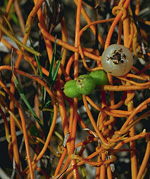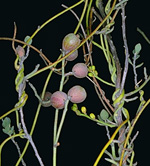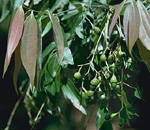 |
This large family is principally tropical, although some species extend into warm temperate climates. In Australia, most species are trees of lowland and upland rainforests in north-east Queensland, extending west to the Kimberley region of Western Australia and south to southern coastal New South Wales. The genus Cassytha (sometimes segregated into its own family) is more widespread in all states especially in south-western Western Australia and including the arid zone.
Characteristic features of the family Lauraceae in Australia include: - trees or large shrubs (except Cassytha, a genus of leafless, parasitic twiners) with simple, usually alternate, entire leaves often with minute oil-dots, sometimes with glaucous undersurface
- flowers small, usually whitish or greenish, usually in panicles, without distinct sepals and petals, instead with 1, 2 or more whorls of free perianth-parts with 3, 4 or 6 parts per whorl
- leaves whorled, linear, membranous, finely toothed, sheathing the stem at base
- stamens several, in whorls with 3 per whorl, often with glands at the base of the filaments, the anthers opening by distinctive flap-like valves
- ovary superior, developing into a 1-seeded berry.
Description
Evergreen, non-parasitic trees or shrubs, or partially parasitic perennial herbaceous vines climbing by twining or scrambling stems. Perennating by taproots. Chlorophyll present, or apparently absent in vines, and then the whole plant yellowish or brownish. Internal secretions not obvious or of resins or essential oils. Plants glabrous or with simple, non-glandular, unicellular or multiseriate hairs. Leaves well developed or much reduced (i.e. to scales, etc.) or entirely absent, alternate and spiral, opposite, or in whorls of 3–5, petiolate or sessile. Stipules absent. Lamina simple, symmetric, lanceolate, ovate, elliptic, oblanceolate, obovate or oblong, rarely orbicular; base cuneate, attenuate, cordate or rounded; margins entire, ±flat, revolute or recurved; venation usually pinnate, with the midrib conspicuous or not conspicuous, and the tertiary venation reticulate or inconspicuous; surfaces usually pellucid-punctate; leathery; distinctive odour absent or aromatic. Domatia absent or consisting of pits or pockets in the vein angles. Male and female flowers occurring on the same plant, or on separate plants, or with all the flowers bisexual, or occurring together with male flowers on the same plant. Inflorescences axillary or terminal, consisting of capitula, glomerules, racemes, panicles, umbels or monochasial cymes. Bracts and bracteoles present. Pollination by insects. Flowers odourless, fragrant or malodorous, sessile or stalked. Floral disc present; nectaries present on the disc and rarely on the stamens. Free hypanthium present or absent. Perianth regular, of 1 whorl only or all whorls ±similar, with 2–3 or (4–) 6 free or fused, sepaloid or petaloid segments, or perianth rarely absent or vestigial, open in bud; perianth cup-shaped, white, cream, yellow, red, pink or green, without contrasting markings, herbaceous, succulent, papery, leathery or membranous. Fertile stamens 2–3, 6, 9–12 or more, opposite to and/or alternating with, or not clearly correlated with and free of the perianth segments, free of the ovary and style, distinct from each other, all ±equal or markedly unequal. Staminodes present or absent. Anthers basifixed, not versatile, opening outwards, sideways, inwards or terminal by pores, by short slits, by longitudinal slits or by valves, 1-, 2- or 4-celled; appendages absent, or rarely with nectary-glands apically, laterally or basally. Ovary superior and sessile or part-inferior. Carpel 1; ovary with 1 locule. Style terminal, single and unbranched, or single and branched above. Ovule 1, sessile or stalked; placentation apical. Fruit a fleshy, indehiscent berry, drupe or a pseudodrupe; the perianth on the maturing fruit dry and persistent or growing larger. Disseminule micro-surface ±smooth, white, cream, yellow, orange, red, pink, green, brown, grey or black, glossy or dull. Seeds 1 per fruit. Aril absent. Cotyledons 2. Embryo straight.
(Note: this description has been generated from the coded data compiled for the key. Any errors in the key data will be reflected in the descriptions.)
A treatment of the family Lauraceae has not yet been published in the Flora of Australia. It will appear in Volume 2.
Australian genera of Lauraceae (as recognised for the Flora of Australia)
† = some species native, others introduced
* = all species introduced
Beilschmiedia
Cassytha
†Cinnamomum
Cryptocarya
Endiandra
*Laurus
Lindera
Litsea
Neolitsea
*Persea

|
  |

Cassytha filiformis (fruits)
Photo: G.Leiper © G.Leiper

Cassytha phaeolasia (habit)
Photo: D.Jones © D.Jones

Cassytha pubescens (fruiting plant)
Photo: R.Hotchkiss © ANBG

Cinnamomum laubatii (fruits)
Photo: H.Nicholson © H. & N. Nicholson

|

| |